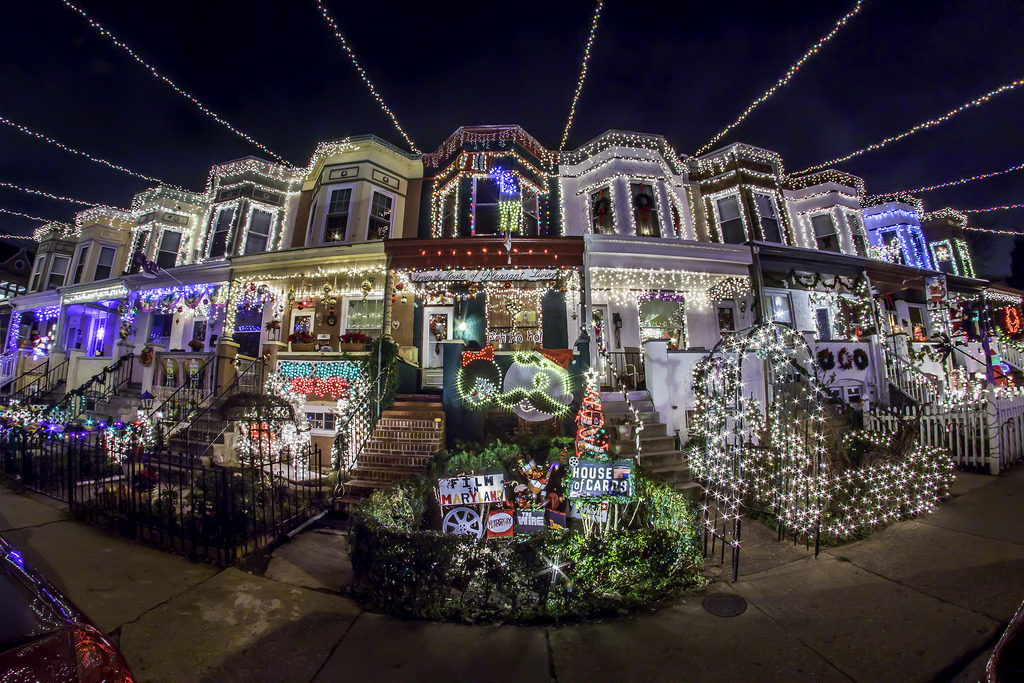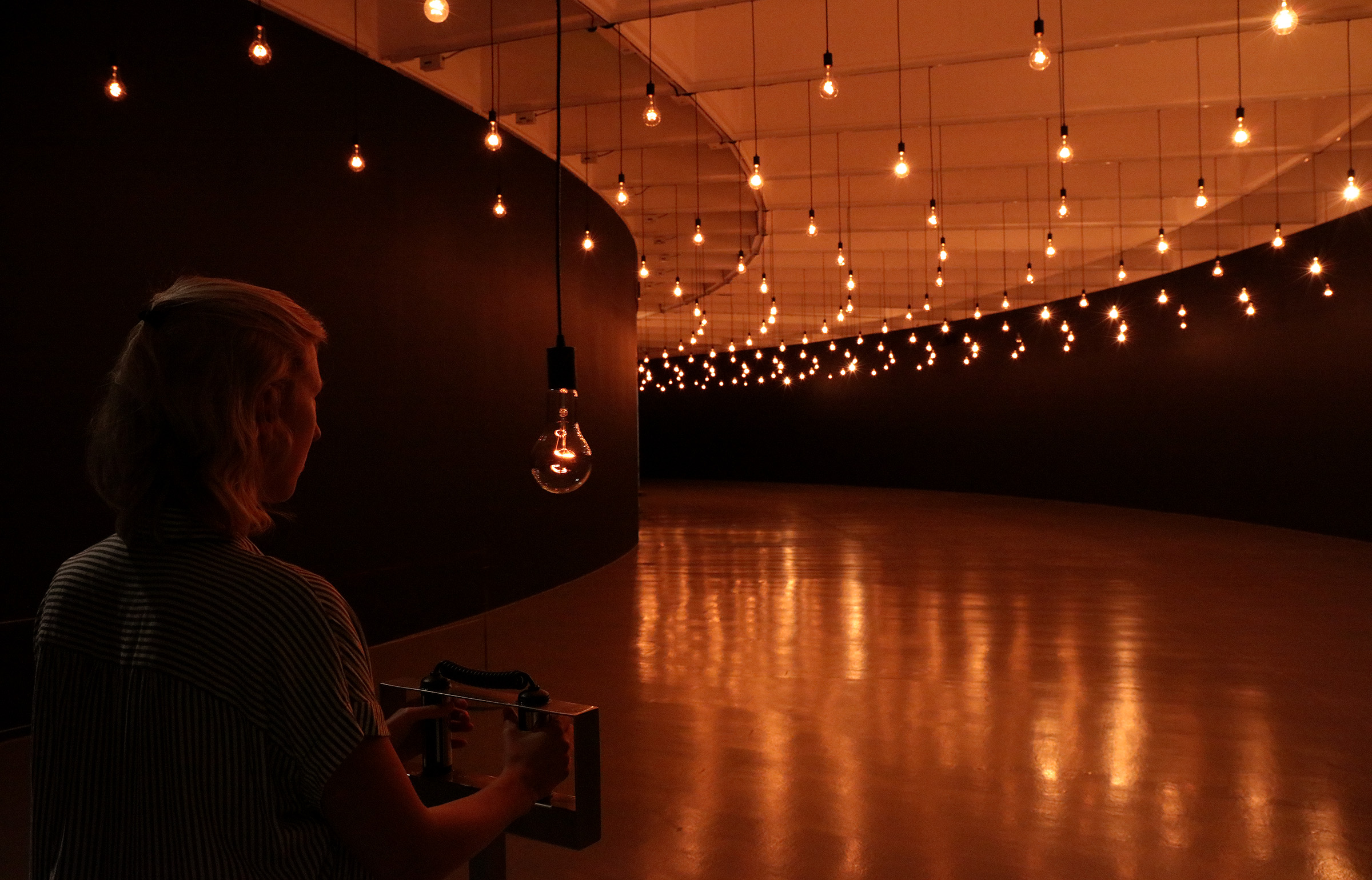Pulse: Rafael Lozano-Hemmer at the Hirshhorn Marries Advanced Technologies of Surveillance to the Theme of Loss by Kerr Houston
Rafael Lozano-Hemmer’s heart rate, at the moment, is 88. That may be a little higher than usual, because he’s currently leading a gaggle of critics and curators through a preview of Pulse, an exhibition of three related works and several supporting materials at the Hirshhorn. But there’s no concealing any nervousness or excitement that he might feel – for shortly after he inserted his finger into a pulsimeter at one end of a gallery, both his heartbeat and a high-resolution image of his fingerprint were projected onto a massive screen. For a moment, at least, usually private details had become eminently public, and the personal had become monumental.
Over the past twelve years, Lozano-Hemmer’s work has repeatedly centered around such themes, using a range of technologies to harvest the biometric data of consenting participants and to then visualize it in imaginative, large-scale formats. Born in Mexico but now based in Montreal, the 50-year-old artist has a global reputation, and his work has recently fascinated viewers in cities such as Madrid, Seoul, and Hobart, Australia. Working with the Hirshhorn, however, presents a series of specific challenges: there are the curving walls, of course, but also the constant waves of tourists and the overarching specter of the American governmental security apparatus. In reprising three of his better-known works, Lozano-Hemmer has created a seductive show that is exquisitely attuned to the structure in which it stands – but that ultimately feels theoretically naive, as it eschews any nuanced criticality and settles instead for outdated tropes and the familiar pleasures of spectacle.

The first room of the exhibition constitutes a sort of prelude, which acts to frame Lozano-Hemmer’s work in several senses. A timeline, designed by the artist, offers condensed summaries of several dozen artistic precedents that involved recordings or replications of human heartbeats: this art historical genealogy effectively situates Lorenzo-Hemmer’s own work in broad historical terms. But his interest in the subject is evidently personal, as well: a fact made clear in a lengthy wall text that details his experiences, as an expectant father, with ultrasound renderings of the heartbeats of his fetal children. Fascinated by the combinations of technologies used to generate an audible sound, Lorenzo-Hemmer soon found himself exploring other ways of using digital technologies to manifest the constant tremors and physical complexity of the human body.
Each of the three sizable installations centers upon these themes. Pulse Index(2010) features, at one end of the room, a single pulsimeter and brief instructions (in conversation, Lozano-Hemmer likes to urge audiences to insert a finger into the orifice). Any viewer who complies sees their pulse rate, electrocardial activity and magnified fingerprint (including remarkably distinct ridges and tiny droplets of sweat) briefly projected on thousands of video screens, which are organized by size into a vast grid. Seconds later, the display shifts again: the user’s print now occupies the largest screen, while each of the other screens features a magnified fingerprint of the most recent participants. And, critically, as a new image is added, the oldest is jettisoned, so that the piece as a whole constitutes an evolving but finite archive. In sum, then, the piece marries advanced technologies of surveillance to the theme of loss; it is, you might say, a digital memento mori.

The second installation (Pulse Tank, which was first shown in 2008) is the most involved. Three shallow ripple tanks are surrounded by pulsimeters, each of which is connected to immersed rods that generate turbulence in time with the user’s heartbeat. Reflections of the resulting waves are then projected onto the museum walls, along with shadows of other viewers. Notably, this is the only one of the three works that facilitates open collaboration, as viewers standing around a pool can work to create intersecting waves of astounding complexity. But it is also responds, delicately, to the curved surfaces of the room in which it stands. Each of the pools is slightly arcuated, so that the projected forms read as rectangular when cast upon the Hirshhorn’s walls. This is an artist, we begin to sense, who places a certain premium upon order and regularity.
The last and largest room is occupied by Pulse Room, which was first executed in 2006, and served as Mexico’s entry in the 2007 Venice Biennale. Again we make our way to a heart-rate sensor, and when we wrap our hands around its grips a single incandescent Edison bulb begins to throb, in time with our sensed heartbeat. Subsequently, more than 200 other bulbs respond briefly in kind – before reverting to individual displays of the recorded heartbeats of previous users. A thudding, percussive thunder – an amplified rendering of the cumulative beats – also fills the room, producing a complex concert and belying the delicacy of the glowing glass bulbs. Fragility and forcefulness are thus paired here, in an affecting combination.

On several levels, then, these works are highly enjoyable. The installations are pristine, the technologies work well, and the premises behind each piece are complex but clear; moving through this show feels like engaging with a massive but elegantly designed machine. At the same time, the works are precisely conceived to muddy familiar dichotomies. The internal, private, and involuntary rhythms of our hearts are externalized in an emphatically visible manner – if, that is, we voluntarily consent to participate. And these works do depend, it’s worth emphasizing, upon the participation of viewers. At the press preview, Lozano-Hemmer emphasized this point, noting that “the project doesn’t exist until the viewer participates.” Indeed, one of the basic thrills of such work involves the sensation – distantly related, perhaps, to the thrill of posting a remark on Facebook – of taking part in a larger project, and of seeing one’s own individuality publicly manifested in relation to a larger community.
But it’s precisely there, I think, that the limits of Lozano-Hemmer’s work begin to come into focus. In 2008, it was still possible to think of Facebook as a largely benevolent platform; back then it really seemed as if the voluntary surrender of personal data might actually effect a new community. In the wake of a string of scandals and the relentless commodification of users’ information, though, it’s hard to maintain an unalloyed enthusiasm. True, there seems to be no shortage of viewers willing to step up and place their finger in one of Lozano-Hemmer’s pulsimeters. But that act now involves a sense of trust, or a leap of faith, that borders on the irresponsible. The initially utopian associations of these pieces have given way to more ominous overtones.

Might that be, though, part of the point? Both the Hirshhorn and the artist seem to want us to believe that it is. The press release alludes to the works’ use of “technologies typically associated with identification and control,” and Lozano-Hemmer regularly speaks of his desire to pervert or to misuse technologies of control. But it’s hard to see how this show represents any sort of substantive challenge to the current culture of digital surveillance; if anything, such work only makes them feel all the more seductive or beguiling. And then there’s the artist’s evident predilection for ordered data and precise display: qualities that feel more disciplinary than liberating. (His fondness for grids and magnified features made me think of, among other precedents, Warhol’s 13 Most Wanted Men and the side-by-side comparisons of handwriting samples from the Riverside and Zodiac killers). Far from perverting technologies of control, then, Lozano-Hemmer’s work largely re-inscribes their logic.
Finally, it’s also worth thinking briefly about Lozano-Hemmer’s notion of participation. At the press preview, the artist accented his interest in creating “a project where we can be together. It is political,” he explained, “to bring people together.” Here, too, we feel cast back to the middle of the last decade, when the emergent genre of relational aesthetics generated a common hope that art really could unify. More recently, however, Claire Bishop has eviscerated that idea, condemning the naiveté of such projects and arguing instead for the importance of antagonism and social unease. Viewed in such terms, though, Lozano-Hemmer’s work feels dated, and touchingly simple. In his highly plotted, immaculate works, there are no distractions and few possibilities for spontaneity or creativity. Tellingly, the one example in which viewers might collaborate – by producing ripples that intersect – results in a series of shimmering, ethereal projected waves. If this is indeed political art, it is an especially ephemeral variant of the form; Brecht, one senses, would not be impressed.

In the end, then, it’s probably wisest to simply admire this work for what it is: a beautiful spectacle. That, at least, was implied in the curator Stéphane Aquin’s observation that “whether you interact or not, the spectacle is absolutely breathtaking.” I won’t disagree; again, this is a ravishing installation, and Lozano-Hemmer’s work does manage to combine touchingly lyrical metaphors (the glowing light bulb as a heart) and unexpected thematic juxtapositions, on a viscerally affecting scale. Instead, I’ll just point out that Aquin’s reference to spectacle recalls a related assertion once made by Andrea Fraser during a public talk. “The forces of spectacle culture,” Fraser observed, can arguably lead to “the demise of radical practice.”
The pulsimeters, then, await, in a tidy formation. The massive screens and bulbs stand ready to transmit a stream of magnified personal data. And the next step is yours.
Pulse is on view through April 28, 2019 at The Hirshhorn.
In the Hirshhorn’s largest interactive technology exhibition to date, three major installations from Rafael Lozano-Hemmer’s Pulse series come together for the artist’s DC debut. A Mexican Canadian artist known for straddling the line between art, technology, and design, Lozano-Hemmer fills the Museum’s entire Second Level with immersive environments that use heart-rate sensors to create kinetic and audiovisual experiences from visitors’ own biometric data. Over the course of six months, Pulse will animate the vital signs of hundreds of thousands of participants.
Top Image: View of Rafael Lozano-Hemmer, Pulse Room, at the Hirshhorn Museum






